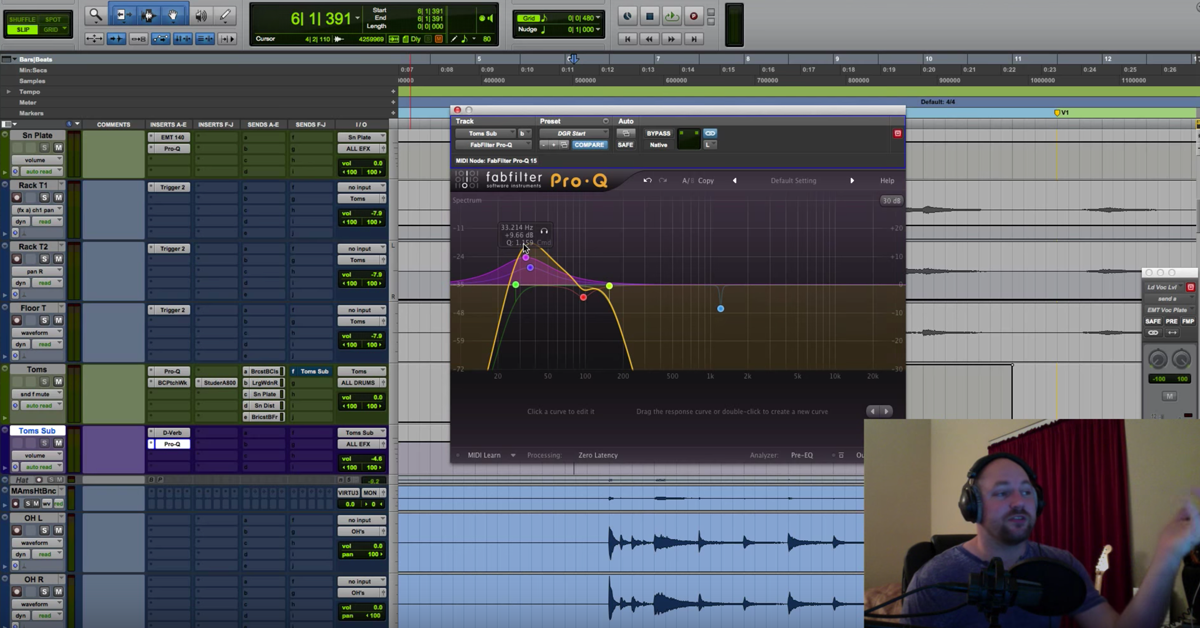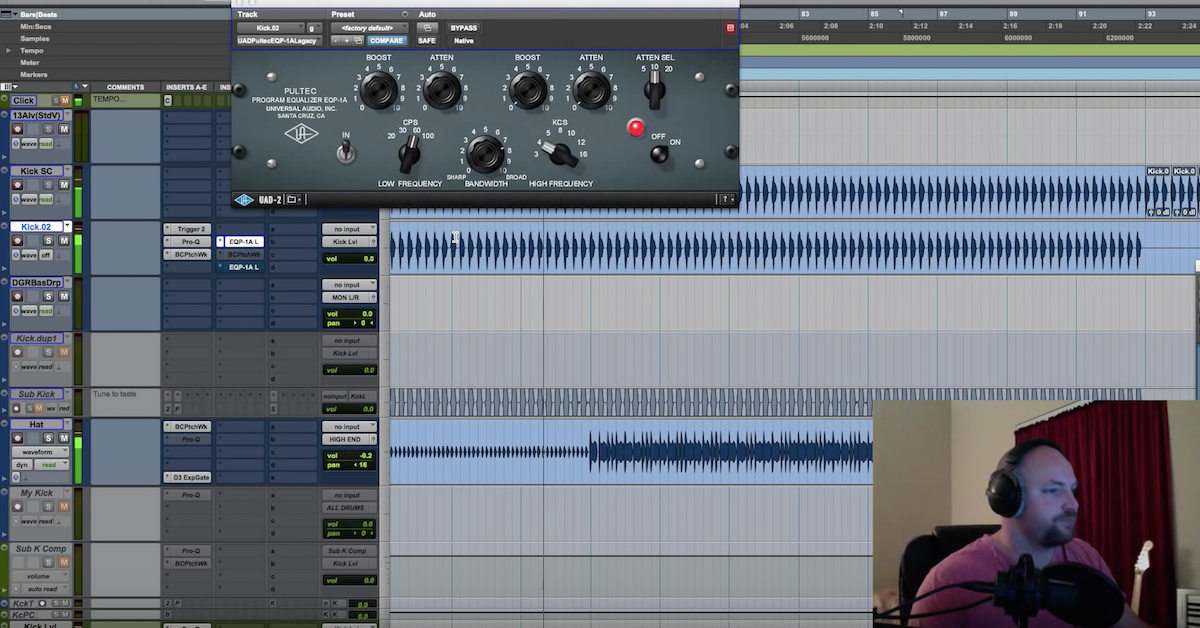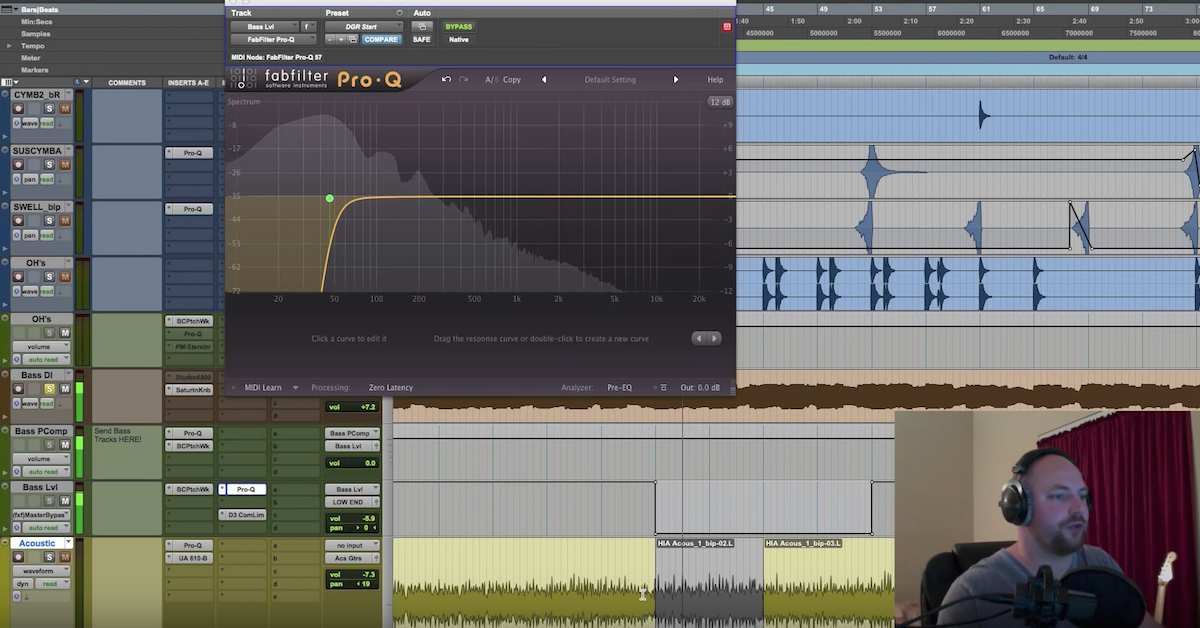Tips for Using Automation in a Mix
Today is Thanksgiving, so I’ve got to make this one pretty quick before my wife catches me doing a tutorial, but I was excited to share this with you. Recently, we hosted a mix contest with The Mix Academy, and there was some key things that I noticed across the board that people could have improved on, and I’m going to create this series. I’m calling it the “How to Win a Mix Contest” series. I think you’re going to love it. Kicking it off, we’re going to talk about automation. I’m going to walk through a bunch of the automation that I did on a recent mix. Hopefully inspire you to get going, stop being lazy. Push up your static mix, that’s great, EQ, balances, whatever, but take your mix to the finish line with some awesome automation.
Let’s jump into this. So what I want to do is just kind of walk you through some of the thoughts I had and automation moves I did in this recent mix. This is from Unbreakables, it’s a song by my man Harry Gettings. We featured this November 2015 if you’re watching this back, and so here we go!
Actually, before I show you the automation moves, let me say, I’m still working on this mix. A disclaimer, right? But I was going for – Or, I’m going for a mix of a modern Dan Bremnes, Modern CCM, love his mixes. The punch, the clarity, I think it’s Ed Cash and those guys doing an incredible job.
I was going for something that meets Rascal Flatts. Modern Pop Rock, Country type vibe. So let me hit play on a couple of these for you so you can feel it out.
[song]
Okay, so that’s Dan Bremnes. Good stuff, go check him out.
Then we’ve got Rascal Flatts.
[reference track]
Okay, and that’s Justin Niebank mixes for Rascal Flatts. He kills it. I love his mixes. But you can feel it’s very different, right? The two styles.
So when I come over to mine, I still have some work to do. I was listening before I went live. Gotta give the disclaimer. I’ve got some clarity issues, I want to brighten up the vocal a little bit and work through it, but this is my mix one we’ll call it. So we’ve got some work to do.
[song]
Okay. I was going to hit stop anyways, Pro Tools. Giving me a glitch.
Alright, so that’s the mix. I’m still working through it, but I wanted to share some thoughts. Even if you hate my mix, these concepts are going to be awesome for you. I think you’re going to dig it.
So first off, let’s take a look at the bass. Here’s the move that I did. Talk about mixing the bass in The Mix Academy, but for the video here, how to improve your mixes for the mix contest, what I did was I – in the verses and the prechorus sections, I automated a high-pass filter on the bass at around 57Hz. That wasn’t just a frequency I typed in and ran with, it’s something that I felt out. Kind of look for “where am I going to get a nice, clean sounding bass that’s not too full, but doesn’t remove the bottom octave completely?” For me it ended up being around 57Hz for the notes that were played in the intro, the verse, and the pre-chorus. Then I’m going to hit play. I’m not going to do a complete detailed instruction of all of this, but I just want to give you the basic idea.
So you’ll see the high pass right here is being automated on my bass level track, which is a blend of a sub track and a bass amp, and here’s what that’s doing.
[mix]
So, the first time in this song that you feel the full weight of the subs in the bass is at the chorus, so it gets bigger, deeper, fuller. I love what that’s doing on the bass, so that comes back up. I’ll show you out here going into the next verse.
[mix]
Okay, so we’ve got a little bit cleaner, smaller sound on the bass whenever it’s in that transitional section, and then into the verse. So that’s cool. Check that out for your mixes.
Then I’ve got some panning arrangement with the acoustic guitars. A great arrangement will force you to do less in the mix when it comes to panning arrangement and things like that. However, in this particular song, I had a left acoustic and a right acoustic. They complemented each other, they played offsetting patterns, it’s a good thing.
But I felt like it just kind of was left and right the whole time, so what I did is I, at the verses, collapsed the acoustics in to about 70% or so, and that sounds like this.
[song]
Okay, so it’s kind of hard left and right, but not really.
Well, then at the pre-chorus, I shot it out hard left and right.
[song]
And then here at the chorus, let me pull open my imager, I’ve got the iZotope Imager. This could be Waves S1, whatever imager you prefer to use, and I’ve just pushed it out in a single band at the chorus to get even wider. So, there you can see the bypass is off for the entire mix, and then I’m un-bypassing it at the chorus, so things get even wider. About what, 34.2% wider.
So let’s hear the difference in that.
[mix before/after]
Okay. So we get a lot of stuff that comes in, a lot of energy filling up the hard left and right, so I wanted these acoustics to just spread out. Maybe it’s for your background vocals you do this trick. Kind of sitting at the verses or the pre-choruses, and then you shoot them out even further at the chorus. Another way to get bigger, wider, fuller, all that kind of stuff.
So there’s the acoustics. The next move is in the electric guitars. Now, the song – I felt like it lacked transitional swells. Some kind of element to kind of pull it in. So instead of re-recording or pulling in any kind of swells, what I did was I used the tracks that were here.
This song is like, ten years old. We’re remixing it for fun because we had live strings and it’s a great tune, but these are guitars I recorded for the track, like, I dunno, seven or eight years ago. It’s pretty crazy. I think this was right when the Eleven Rack came out.
Anyways, story aside, here is the automation I wrote for the electric guitars, right before the chorus.
[song]
Okay, these little moves can go a long way, and so when I was listening to the mixes for The Mix Academy mix contest, I felt like everything just kind of stayed put. There wasn’t a whole lot of automation. There was some cool delay effects and things going on left to right, but there wasn’t so much an up and down movement to anything.
So this was a cool little trick. Let me play that one real quickly in solo, because I’ve got two things going on here. I’m riding the fader for building anxiety, building some kind of tension to get the thing to explode, but then at the first hit, at the transient for the chorus, I have a little bit of a kind of push to kind of push the guitar into the chorus, and then pull it back a little bit.
So you get the impact, but then you get it to sit right where I want it. So let’s take a listen to this in solo.
[electric guitars]
Listen to that again there at the end.
[electric guitars]
Okay. Not necessary on every single song. These are just ideas, but to me, I feel like that just kind of helps push the guitars into that next section.
[song]
Okay. So I may be crazy, and that may suck, but I think it sounds good.
The lead guitar, we had an 80’s lead guitar – I told you this was an old song – and I just kind of rode this real gentle. Nothing crazy. Let’s come out here to where there’s a little bit more of a push. I think that think has like, a solo or something.
[lead guitar]
Yeah, just pulling up the end of it, but just creating some movement. Small, small moves here. Some stuff further down, but let’s talk about the keys.
What I did for the keys was I broke it out, at least for the first chorus. It was a concept video. I didn’t end up doing it for the other parts, but I took and EQ’d the piano at the verses to have a certain sound, then at the chorus, I brightened it up so it would cut through the mix and did some other things to it.
But let’s talk about the automation move. The – this is a good spot right here where we’ve got the piano. Just kind of moving it, pushing it with what the pianist is playing. Listening to that, feeling it out, and then at the transition here…
[song]
Really subtle stuff, right? But if that automation is gone, that piano is down there. Let’s take a listen if it’s off. The automation is off right now. No volume change.
[song]
Versus on.
Just creates a little, tiny bit of something that across the mix, these small moves are going to make a big difference for you guys. We’ve got some other stuff out here. Let’s see, there’s another way that I used the – actually, two things I want to show you here. This is like, a reverse effect.
[mix]
Okay, so there is a piano rising up, but then I also took the beginning of the guitars, and copied them, put it on a new track with the same processing, reversed them, faded them in, consolidated that, and then even automated that to rise even more.
[mix]
Cool. So little things to keep an eye out for that you can do. We’ll talk more about guitar automation maybe in another video, but let’s move on. We talked about piano. The organ, same thing. Just kind of pushing that up. Creating a pad from it. Extending it a little bit as the track builds.
I’ll hit play on that.
[song]
That’s really subtle, but if I would’ve just left that, you probably wouldn’t have even heard the organ, so just kind of letting that grow, and at the end when it died out, lifting that up quite a bit so it sustains and you feel a little bit of that.
Let’s talk about strings, because we had live strings in this song. Again, if you want to mix this, go to themixacademy.com/blackfriday. We’ve got some great deals for you. Links are in the description below. $5 gets you access to these tracks. The strings we had what, an arc bass, we had cello, viola, and violin section. They were all tracked at the same time. Awesome players here in Orlando, Florida.
Stark Lake Studios. Harry, his family, they own Stark Lake Studios. Give a shout out to them. Incredible session, incredible stuff here. The thought I had with this was to write automation to pick out the good parts for each individual section of the strings. Stuff I didn’t like, I put kind of down in the mix individually, and then as a whole, I automated the string buss here.
So, first I’m just trying to get what’s the good stuff that each part’s contributing to the song, and not necessarily the string section, but the song. How is it complimenting the song? And then once I have that automation written individually in those sections, I went to the string buss, and kind of helped perform the strings as one instrument as a whole.
So let’s take a listen to some of that. First up, you can hear the arc bass and the cello are in the mix pretty decent volumes, and then also panning automation. We’ll show you that.
[song]
Okay, so going into the chorus, we have bass that gets fuller, we’ve got more guitars that come in, things are getting big, it gets a little bit dense, so what I did is I listened to the arc bass and the cello here… Let’s solo these guys for us.
[arc bass and cello play]
Okay. For me, I was listening, I didn’t feel like that complimented the chorus as much as the fullness and the kind of smooth, driving effect that I was getting from the guitar, so I chose to automate that volume down a little bit. Hear that.
[song]
Just get a nice kind of groove going. It’s smooth, you can bob your head to it a little bit, but with that, it was kind of like you know, articulate type thing, and I just wasn’t feeling that, so I brought the volume of that down throughout the song, and there was a couple spots where I picked up some automation and increased the sustain so you can feel the low end in the cellos and whatnot.
But then the violas and the violins, I don’t think I wrote automation for their volume. I used this. So once I got them cohesive with each other, I wrote automation on the strings buss here for the most part, but I did – what’s this one right here… Strings, the panning automation.
So I did do panning automation for all of these. Let’s go and take a look at that. So, this starts at 22 off to the right, and 30, the cello is 15 and 8, the strings are where I did the panning – okay. Viola and strings at the end here. So let’s take a look at that.
So, these guys are pretty much on the right side for the duration of the mix until the end. I wanted this to get bigger, wider, fuller. A big explosion fireworks show at the end, so I’ve got these exploding. Let’s take a look at that.
[song]
So, for the duration of the song until the end, the violas and the violins, the strings are just off to the right, and then the cello and the arc bass are kind of down the middle off left and right.
Well then, at the chorus at the end, I explode the strings out wide. It becomes a hard left and right type of thing, and they just kind of sit on top like a pad. Really pretty, really beautiful. I think it works. So that’s another thought.
But then here, the strings automation – the strings should probably even come up a little bit. As I’m talking to you guys, I’m coming up with mix notes, but let’s take a look at some of these automation moves here.
[mix]
So again, kind of using the strings as a transitional element, but then at the chorus, just kind of tucking them in a little bit. However, they come in with a part here that I really like, so I pushed them up.
[mix]
And as I listened back, that can probably use an automated EQ move to pull out some upper-mid range to bring some clarity to just that part. I kind of like the way the strings sit overall, but I feel like in that one little section we need to hear that even more, so.
Little moves across the board. I will save the rest of that stuff for when you join The Mix Academy and you come in and see every little move that I do. The vocal right here, I’ve got a few minor changes. I automated the parallel compression down a little bit at the first verse, because it’s very open. It’s piano and vocals. So just a little bit different there versus at the chorus, I pulled that up. This section, for whatever reason, I wanted more parallel compression, but let’s talk about the volume here.
So at the end of some of these phrases, I’ve written out some fades. So let’s take a listen to that.
[song plays]
Really subtle stuff. Let’s go out to – there’s one or two that was a little bit more dramatic.
[song]
So getting a little creative with this one, but again, it’s about pushing the faders, letting things move a little bit. Don’t just let them sit still. This one is kind of backing off, and then it comes forward before the next section.
[song]
And if I remember correctly, I had a note to automate some effects there. Let me see, did I do that? No, I didn’t. So let’s go ahead and draw something in here. Let’s go like that and see if we can get something cool.
So a little bit of a modulation effect to grow as the volume of – the level is actually decreasing, so it’s kind of taking a little bit of a transition of the effect here.
[song]
It could probably be even more dramatic with it. Let it build all the way to the end. That might be a bit much, though.
[song]
Could put a reverb there, maybe a delay or something cool to give it something more interesting, but anyways, having fun with automation, I felt like the mixes lacked automation. Again, there were some cool effects left and right. Delays, tremolo type things, but going – not tremolo, vertical, but side-to-side panning automation in the mixes.
But hopefully you see that we can really get crazy and have a lot of fun. Again, the drum automation master class for you guys to check that out. If you want to learn more, themixacademy.com. Get your hands on multi-tracks, follow me as I mix. I break down songs start to finish. There’s actually a new bonus primer series that’s like, ten videos of all of the ways that I setup mixes and prep mixes, and all of that good stuff so that whenever you come into The Mix Academy, you can watch that, then each month I don’t have to explain that stuff again, we can get right to establishing a vision, putting a road map in place, listening to the song, and talking about that journey and that process, so.
I hope you dig this. More to come. We’re going to talk about – well, I’m going to keep it a secret. We’re going to talk about four or five other things. Mastering will be one of them for sure. A lot of crushed mixes submitted to us.
But I hope you dig that, and we’ll catch you in the next one. How to Win a Mix Contest series from David Glenn Recording.





